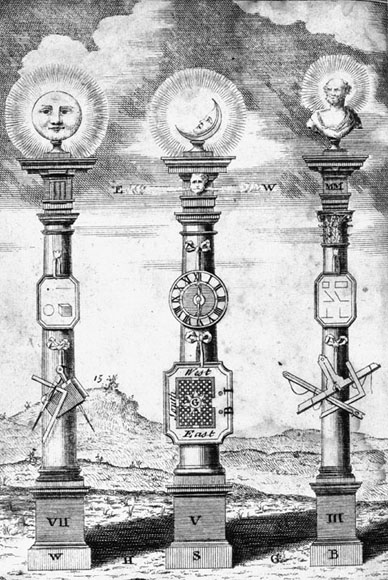Get Today in Masonic History into your Inbox. Sign up today for one of our email lists!
Need an article for your Trestleboard/Newsletter see our Use Policy
Ancient Landmarks of Freemasonry

Today in Masonic History we discuss the Ancient Landmarks of Freemasonry.
Ancient Landmarks of Freemasonry are considered unchangeable and are often used to define Freemasonry.
The idea of an Ancient Landmark is said, by some, to refer to the Bible. In the Book of Proverbs it states "Remove not the ancient landmark which thy fathers have set." There are also precedents in Jewish law stating "Thou shalt not remove thy neighbors' landmark, which they of old time have set in thine inheritance." In either case it refers to an area of land, possibly with stone markers defining the property. Relating it to Freemasonry, the landmarks define the due bounds of a lodge, Grand Lodge or Grand Orient.
Note, I will use the term Grand Lodge generically from this point forward in this article, it is meant to refer to a Grand Lodge or a Grand Orient.
It is important understand, since Freemasonry has no controlling authority, individual Grand Lodges may vary in which Ancient Landmarks are recognized. Some Grand Lodges may recognize as few as three and others may recognize as many as 40, sometimes more.
In 1723, in Anderson's Constitutions it's stated "Every Annual Grand Lodge has an inherent power and Authority to make new Regulations or to alter these, for the real benefits of this Ancient Fraternity; provided always that the old Land-Marks be carefully preserved." In the original book it did not list the Landmarks.
In 1856, Albert Mackey defined what he thought were the 25 ancient landmarks. He also specified traits, in his opinion, every landmark possesses. These traits are:
- notional immemorial antiquity
- universality
- absolute "irrevocability"
As previously stated a Grand Lodge can recognize any landmarks it desires. The Landmarks it recognizes will have an effect on whether they are recognized by other Grand Lodges. Six of the most common landmarks are:
- belief in a Supreme Being or monotheism
- belief in the immortality of the soul
- a book or volume of sacred law as an indispensable part of the "furniture" (or furnishings) of the Lodge
- the legend of the Third Degree
- the secrets of Freemasonry: The modes of recognition and the symbolic ritual of the Lodge
- a Mason be a man, freeborn, and of lawful age
In the 1950's the Commission on Information for Recognition of the Conference of Grand Masters of Masons in North America upheld 1 and 3 as landmarks. They also added "Discussion of Religion and Politics is prohibited in the Lodge." The Conference of Grand Masters of Masons in North America is an association of Grand Lodges having some level of amity with each other. They get together annually to discuss issues effecting all of the Grand Lodges in the region. There are other such conferences around the world with a similar purpose. Although the North American Conference did uphold those three landmarks, there is no obligation for any Grand Lodge associated with the conference to uphold those specific landmarks. The Conference should be thought of as a "United Nations" where individual Grand Lodges are represented, but the Conference has no authority in the individual Jurisdictions.

